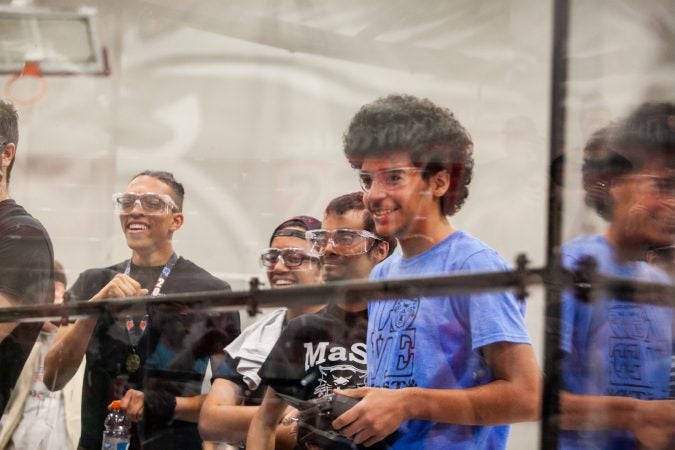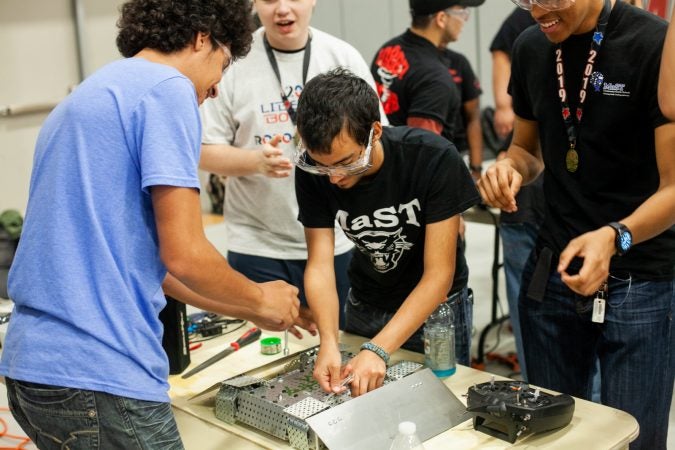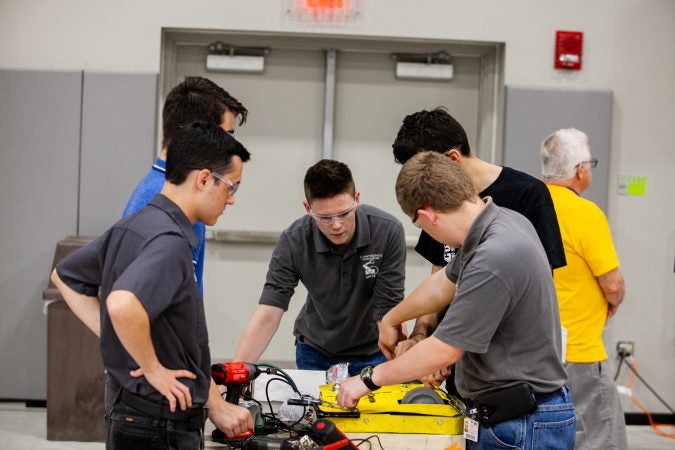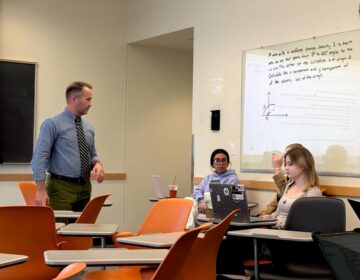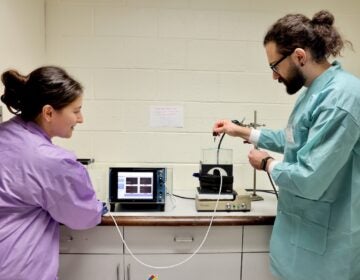Battle of the metal warriors: Local high schools vie in first regional Liberty Bots competition
With a focus on workforce development in manufacturing, students from local high schools were partnered with representatives from local manufacturers.

Ashley Yates of Harry S. Truman High School works on her team's robot between rounds at the Liberty Bots competition Saturday at Montgomery County Community College. (Brad Larrison for WHYY)
The robot she helped create was in a cage fight to the death, but for Jasmine Morris, a senior at Trenton Central High School, it all felt “cathartic.”
Gary the Robot may have lost, but he didn’t go down without a fight. Morris and her student team were able to battle an opponent school’s robot until the end of the match, maneuvering the metal box on wheels with a remote control, swinging Gary’s metal arm in a circular motion that whacked its robotic rival over and over.
“All our months of hard work, even though we lost, it’s kind of like, ‘Yes, we finished something.’ We didn’t win, but we finished it,” Morris said.
That satisfaction of creating a functioning robot was pervasive Saturday at the first Liberty Bots Competition at Montgomery County Community College. The tournament, in which eight schools from the Delaware Valley competed, was the first regional contest of the National Robotics League, which hosts these robo-battles across the country to help inspire the next generation of engineers.
Upper Bucks County Technical School designed the winning battle bot.
Each student-made robot was judged on things like control or aggression — if the robot didn’t knock out its foe within two minutes. Between rounds, the students rushed to repair any damage.
The National Robotics League has a focus on workforce development in manufacturing. So when John Shegda of M&S Centerless Grinding, president of the National Tooling and Machining Association’s Delaware Valley chapter, began organizing the competition, he made sure each school was paired up with a representative from a local manufacturer that would give advice and help make the robot components the students designed at school.
“By promoting this competition across the region here, all the way from Reading down to South Jersey, we are giving people a different side of what advanced manufacturing is in the United States and particularly this region — that it’s about high-tech and future growth and not just an old industry that is on its way out,” Shegda said.
Cosmo DiLiegro, an engineering teacher at Harry Truman High School in Bucks County, jumped at the opportunity to have his students involved when he first heard about this regional competition two years ago.
DiLiegro’s students were teamed up with Raymond Dettmar from KVI, a manufacturing company based in Montgomery County.
On top of mentoring the students, Dettmar’s role included turning their 3D models and designs into physical reality.
Truman’s robot, Theseus — named for the mythical king and founder-hero of Athens — won its first round against Jeff, the robot representing Eastern Regional High School in Voorhees, New Jersey.

For the students at Truman — and many of the students at the competition — it was the first time they saw the technical skills learned in their engineering courses come alive. Though on Saturday, things started out a little rocky for Truman’s team: they left Theseus’ batteries at school.
The Truman students played a part in physically building Theseus too. They had trouble finding the right parts to make its wheels, so they 3D-printed them in the school’s shop and added rubber bands to provide some traction.
Jacob Vanderwoude, a senior at Truman, said he and his classmates started designing Theseus last summer.
Vanderwoude, who held the controls Saturday, said getting the chance to do the robot battle was worth all the trial and error and adaptation of the last several months. He plans to study computer engineering at Drexel University in the fall – and feels as if he has a head start after the creation of Theseus.
“It feels like this entire experience is very worthwhile to the students because lots of the time they just don’t see the real-world applications of anything they learned. But everything I’ve learned throughout engineering, the engineering courses I’ve taken, has applied to this robot,” Vanderwoude said.
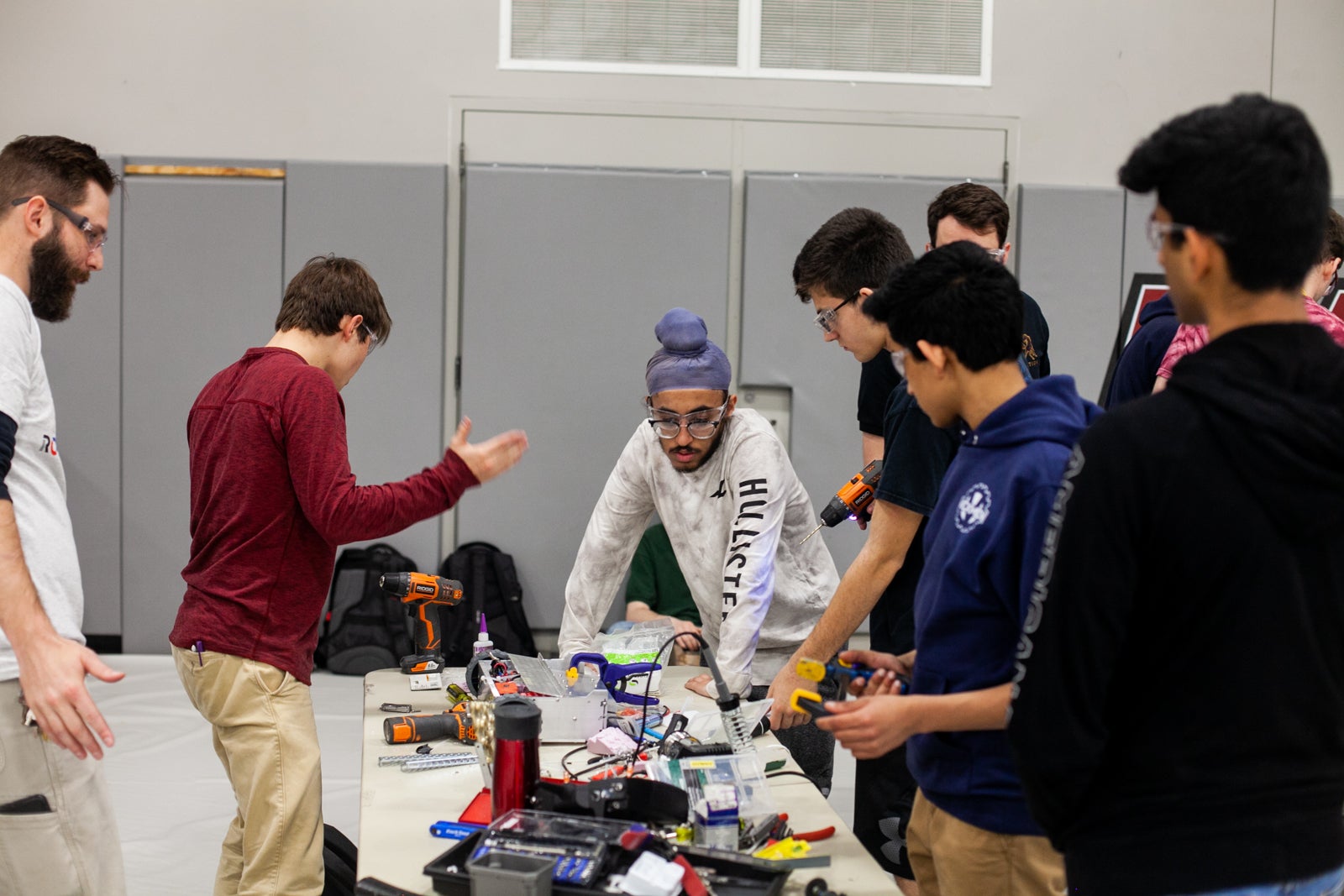
Shegda said he hopes that as these schools’ engineering programs mature, one day they’ll get to compete at the national level. He also hopes to see the number of schools double at next year’s local competition.
“There are many areas of the country that have 60, 70 teams competing in this competition on an annual basis, so that’s what we are hoping to do here,” he said.
Competitions like these are healthy for the future of the local manufacturing industry, Shegda added.
“It is all about raising the awareness of what advanced manufacturing is, opportunities in engineering … opportunities that can really change the world,” he said. “My company itself is just a small 40-person company, but we are making things that are saving people’s lives, that are going into outer space, that are keeping jets in the air. That is what these kids are learning throughout this process … that the experiences that they are getting by interacting with the companies that they are paired with, they get to understand this a lot better and they can take that forward and hopefully come back and stay in the region and make us stronger.”
Jasmine Morris said she’ll study electrical engineering at the College of New Jersey. As a woman in STEM, she said, it felt validating to know how respected she was by her teammates and competitors throughout the tournament.

“I just feel like it’s proof that times are changing,” Morris said. “You know, everyone can get together, any race or gender, and make robots and destroy them and just have fun.”
WHYY is your source for fact-based, in-depth journalism and information. As a nonprofit organization, we rely on financial support from readers like you. Please give today.





